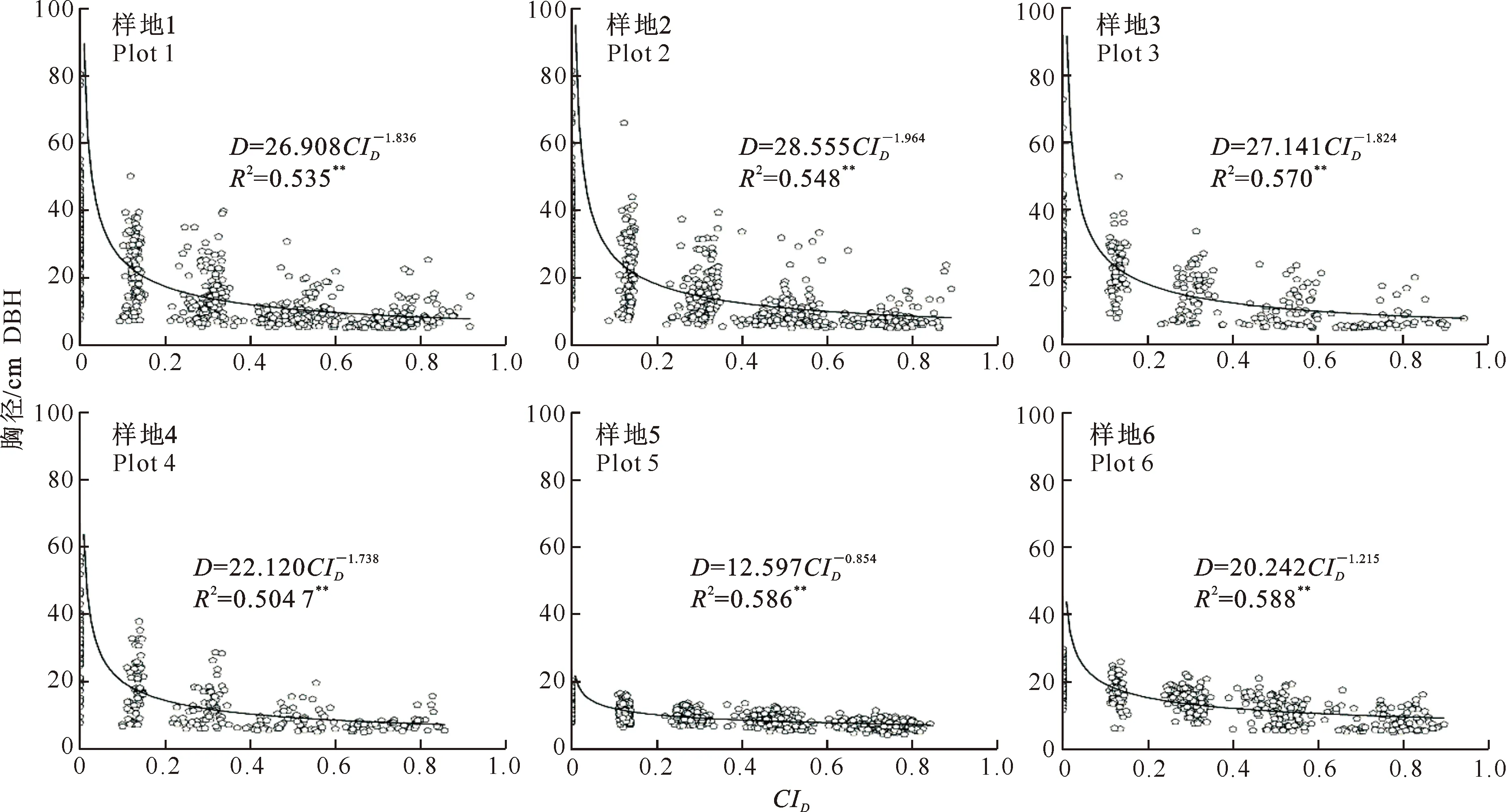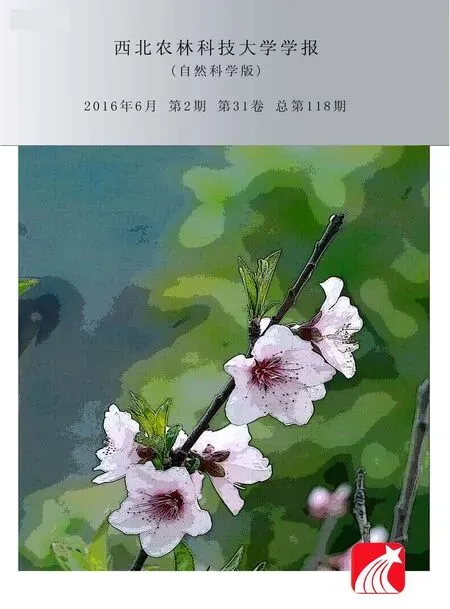基于交角的林木竞争指数应用研究
白 超,赵中华,胡艳波
(中国林业科学研究院 林业研究所,国家林业局林木培育重点实验室,北京 100091)
基于交角的林木竞争指数应用研究
白超,赵中华,胡艳波
(中国林业科学研究院 林业研究所,国家林业局林木培育重点实验室,北京 100091)
[摘要]【目的】 基于交角的林木竞争指数(CI)简洁,能同时表达出竞争木上方的遮盖和侧翼的挤压。探讨不同林分用胸径(D)或通过胸径-树高(D-H)曲线预估树高后替代实测树高计算该竞争指数的可行性,以期给出基于交角的林木竞争指数的最优经验计算途径。【方法】 以3个地区共6块样地的天然林和人工林为研究对象,利用全站仪测定并记录林木坐标、树种、胸径、树高、冠幅和健康状况,并计算和分析各样地林木通过胸径得到的竞争指数(CID),通过胸径-树高曲线预估树高后得到的竞争指数(CID-H)与通过实测树高得到的竞争指数(CIH)间的关系。【结果】 不同森林类型林分通过胸径和胸径-树高曲线预估树高后计算得到林木竞争指数的2个经验计算途径都是可行的,且都能表达出通过实测树高计算得到林木竞争指数(CIH)结果的95%以上。2个经验计算途径的效果与胸径-树高曲线模型精度呈显著正相关,当胸径-树高曲线模型精度低(R2<0.53)时,CID-H效果略差。【结论】 由于CID-H计算过程较复杂,且当林分胸径-树高曲线模型精度较低时,竞争指数CID-H的应用效果比竞争指数CID略差,因此以胸径替代实测树高可作为该竞争指数的最佳经验计算途径。
[关键词]基于交角的林木竞争指数;胸径-树高曲线模型;经验计算途径
林木的微环境取决于林分的结构,林分结构是决定林木生态位的关键要素,林木的活力由林木本身的遗传因素及其所处的微环境决定。在生态学中林木的活力通过竞争来表达。竞争指两个或多个植物体对同一环境资源和能量争夺中的相互作用[1],这意味着由于相邻竞争木的存在而使环境资源减少,从而使邻近有机体之间互相影响和阻碍,竞争的结果产生了植物个体生长发育上的差异[2]。竞争现象在植物群落中普遍存在,并且对植物群落的结构及其演替进程具有重要影响,一直是生态学家研究的热点之一。
竞争指数是描述林木间竞争关系的一种数学表达式,反映林木所承受的竞争压力,这取决于林木自身状态(如胸径、树高和冠幅等)及其所处的局部环境(邻近树木的状态)[3]。当前,竞争指数一般可分为与距离有关的竞争指数和与距离无关的竞争指数[4-9]。与距离有关的竞争指数能精确估测林木生长,并有助于提高林木生长和发育生长模型的预估效果,因此近年来得到广泛发展。由于林木地下部分的竞争分散且难预测,与距离有关的竞争研究主要集中在地上部分[10],如从树冠范围尺度上研究竞争的树冠面积重叠竞争指数[11-14]、光照竞争指数[15]等,考虑林木树高研究竞争的高度角竞争指数[16]和树高大小比值竞争指数[17]等,基于林木胸径大小对空间挤占提出的Hegyi简单竞争指数[18]、复杂竞争指数[19-20]等。惠刚盈等[2]综合考虑了林木的树高和胸径大小,基于交角原理、以大小比数为权重提出了基于交角的林木竞争指数,其生物学意义在于对象木所受到的竞争压力在距离保持不变时随竞争木树高的增加呈非线形增加,或在竞争木树高一定时随距离的变远而呈非线性减小,简洁地表达出竞争木上方的遮盖和侧翼的挤压。由于林木胸径在林分中测定简单、方便、准确且花费低,所以通常的竞争指数(如Hegyi指数、BAL指数[21])都直接包含或隐含胸径变量。在林分中测定林木树高难度较大、速度较慢且误差较大,给基于交角的林木竞争指数实际应用带来较大困难。为解决上述问题,本研究选取3个地区共6块样地的天然林和人工林,探讨不同林分用胸径或通过胸径-树高曲线预估树高后替代实测树高计算该竞争指数的可行性,以期给出基于交角的林木竞争指数的经验计算途径。
1材料与方法
1.1研究区概况
本研究以天然林和人工林样地为试验对象,其中天然林试验样地分别位于吉林蛟河和甘肃小陇山。人工林样地位于北京市九龙山自然保护区。
在吉林省蛟河林业试验区管理局东大坡自然保护区内(127°35′~127°51′ E,43°51′~44°05′ N)设置2 块永久性样地(表1中1号和2号样地),境内平均海拔在400~500 m,地势为东北部山高坡陡,而西南部地势平缓。该区属温带大陆性季风山地气候,全年平均气温1.7 ℃,降雨集中在6-8月份,年均降水量700~800 mm,无霜期120~150 d,平均积雪厚度20~60 cm,土壤结冻深度1.5~2 m,土壤为暗棕壤。
在甘肃省南部小陇山百花林场(104°22′~105°43′ E,33°30′~34°40′ N)设置2 块永久性样地(表1中3号和4号样地),境内海拔在700~2 500 m。该区属暖温湿润-中温半湿润大陆性季风气候,年平均气温7~12 ℃,年均降水量600~900 mm,年日照时数1 520~2 313 h,无霜期130~220 d,区内秦岭以北的土壤为灰褐土,以南为黄褐土。
在北京市门头沟区九龙山自然保护区(115°59′~116°06′ E,39°54′~39°57′ N)内设置2块永久性样地(表1中5号和6号样地),境内海拔在400~1 000 m。该区属大陆性东岸季风气候,年平均气温11~12 ℃,年均降水量600~700 mm,年日照时数2 500~2 700 h,无霜期190~200 d,区内400 m以下为山地粗骨褐土,400 m以上为山地淋溶褐土。
1.2样地设置与调查
不同地区永久性样地设置面积见表1,对样地内所有胸径≥5 cm的林木进行挂牌标号,利用全站仪(TOPCON-GTS-602AF)测定并记录林木坐标、树种、胸径、树高、冠幅和健康状况等。

表 1 本研究设置的6块样地概况Table 1 General conditions of six sample plots in this study
1.3数据分析方法
1.3.1胸径-树高曲线模型本研究使用比较常用的胸径-树高曲线模型(表2),应用SPSS 18.0软件拟合6块样地核心区域数据,根据P 值判断回归模型的可行性,最后利用模型决定系数R2确定最优模型。

表 2 胸径-树高曲线模型Table 2 Height-diameter model
注:H为树高;D为胸径;a,b,c为参数。
Note:Hrepresents tree height;Drepresents diameter at breast height (DBH);a,b,andcare parameters.
1.3.2基于交角的林木竞争指数为便于表述,本研究将惠刚盈等[2]提出的用实测树高计算基于交角的林木竞争指数(u_α_CIi)简写为CIH,将利用胸径-树高曲线模型预估的树高代替实测树高计算基于交角的林木竞争指数简写为CID-H,将胸径直接代替树高计算基于交角的林木竞争指数简写为CID,计算公式如下:





式中:Hi为对象木的实测或预估树高,Hj为相邻木的实测或预估树高,Di为对象木的胸径,Dj为相邻木的胸径,Lij为对象木和相邻木之间的距离,n为结构单元内相邻木的株数。
应用Visual Basic高级程序设计语言,以对象木和最近4株相邻木作为一个结构单元,编制计算基于交角的林木竞争指数程序。为避免边缘效应对林分结构的影响,计算时缓冲区设置为5 m。
2结果与分析
2.1各样地胸径-树高曲线模型的确定
所有样地拟合的胸径-树高曲线模型均通过了显著性检验(P<0.001)(表3),模型的决定系数R2为0.497~0.849,拟合的胸径-树高曲线均呈现随着胸径的增大树高先增后趋于稳定的趋势。除样地3的最优胸径-树高曲线模型为幂函数外,其余样地的最佳模型均为抛物线函数。排列各样地决定系数R2,依次为样地4(0.849)>样地3(0.799)>样地1(0.721)>样地6(0.545)>样地2(0.529)>样地5(0.497)。

表 3 各样地最佳胸径-树高曲线模型的模拟结果Table 3 Best simulation results of height-diameter model in each plot
2.2通过3种途径计算得到的竞争指数间的关系
从6块样地的竞争指数CIH与CID(图1)或CID-H(图2)的回归分析可以看出,CIH与二者之间具有高度相关性,其决定系数R2均大于0.95,说明CID和CID-H可以表达出CIH结果的95%以上。二者关系可用线性函数CIH=bCID或CIH=bCID-H进行表达,因为线性函数系数b∈(0,1),且CIH∈[0,1)[2],所以CIH 图 1 6块样地竞争指数CIH与CID之间的关系Fig.1 Relationship between competition indexes of CIH and CID in the six plots 图 2 6块样地竞争指数CIH与CID-H之间的关系Fig.2 Relationship between competition indexes of CIH and CID-H in the six plots CIH与竞争指数CID或CID-H之间的R2与样地内所有树种拟合的胸径-树高曲线模型R2均呈显著正相关(表4),即当胸径与树高相关程度越高,则竞争指数CIH与CID或CID-H之间的相关程度就越大。对比各样地CIH与CID或CID-H之间的决定系数R2,发现样地1、3、4、6的CIH与CID-H之间的R2都大于CIH与CID之间的R2,但样地2、5则相反。从表3可以看出,在样地2、5中,拟合的胸径-树高曲线模型精度低(R2小于0.53),使得预估树高与实测树高之间误差增大,因而使计算所得的竞争指数CID-H与CIH之间的相关程度降低。由此可见,以胸径直接替代树高能更稳定有效地计算该林木竞争指数。 表 4 胸高关系与竞争指数间关系的相关分析Table 4 Correlation analysis between height-diameter model and each CI 注:*代表决定系数显著(P<0.05)。 Note:* represents the correlation between determination coefficients is significant (P<0.05). 2.3各样地竞争指数与对象木胸径间的关系 不同生长阶段的林木个体大小不同,也可反映出不同的竞争能力。大量研究[2,22-23]表明,大的林木具有强的竞争能力,即树体越大,所承受的竞争压力越小,二者服从幂函数关系[24-26],6 块样地拟合的竞争指数与林木胸径大小的关系进一步证实了这一规律(图3和图4)。由图3和图4可以看出,竞争指数CIH与林木胸径大小的相关程度相对高于CID的,但二者对6块样地拟合结果的趋势是一致的,均为样地6>样地3>样地5>样地2>样地1>样地4。由此可见,竞争指数CID能替代CIH有效地表达出不同大小的林木所承受的竞争压力。 图 3 6块样地竞争指数CIH与生长因子的相关性Fig.3 Correlation between competition index CIH and growth factor in the six plots 图 4 6块样地竞争指数CID与生长因子的相关性Fig.4 Correlation between competition index CID and growth factor in the six plots 3结论与讨论 (1)用胸径直接替代基于交角的林木竞争指数中的树高是可行的。CID和CIH都能有效地表达出不同大小的林木所承受的竞争压力,竞争指数最高的是小树,因而小树承载的竞争压力最大,其次是中树,而大树的竞争指数最低[2,22-23]。虽然竞争指数CIH与胸径的拟合精度稍高于CID的,但二者对6块样地的拟合结果趋势是一致的。 (2)基于交角的林木竞争指数在实际应用中可用树高曲线间接途径进行计算,但应用效果取决于树高曲线模型的精度,当胸径-树高曲线模型精度较低时,竞争指数CID-H并没有比竞争指数CID更好地反映林木的竞争,因此,以胸径替代实测树高可作为该竞争指数的最佳经验计算途径。 图 56块样地竞争指数与对象木胸径等级的关系 Fig.5Relationship between competition index and objective tree DBH classes in the six plots (3)竞争指数CIH [参考文献] [1]辛营营,韦新良.青山湖针阔混交林优势树种竞争的数量研究 [J].浙江农林大学学报,2011,28(4):601-606. Xin Y Y,Wei X L.Dominance in a mixed conifer and broadleaved forest of Qingshan Lake [J].Journal of Zhejiang Forestry College,2011,28(4):601-606. [2]惠刚盈,胡艳波,赵中华,等.基于交角的林木竞争指数 [J].林业科学,2013,49(6):68-73. Hui G Y,Hu Y B,Zhao Z H,et al.A forest competition index based on intersection angle [J].Scientia Silvae Sinicae,2013,49(6):68-73. [3]唐守正,李希菲,孟昭和.林分生长模型研究的进展 [J].林业科学研究,1993,6(6):672-679. Tang S Z,Li X F,Meng Z H.The development of studies on stand growth models [J].Forest Research,1993,6(6):672-679. [4]邵国凡.红松人工林单木生长模型的研究 [J].东北林业大学学报,1985,13(3):38-46. Shao G F.Research on individual growth model ofPinuskoraiensisartificial forest [J].Journal of Northwest Forestry University,1985,13(3):38-46. [5]张跃西.邻体干扰模型的改进及其在营林中的应用 [J].植物生态学与地植物学学报,1993,17(4):352-357. Zhang Y X.Application and improvement of the neighborhood interference model [J].Acta Phytoecologicaet Geobotanica Sinica,1993,17(4):352-357. [6]孟宪宇.测树学 [M].3版.北京:中国林业出版社,1996:88-288. Meng X Y.Forest mensuration [M].3th ed.Beijing:China Fo-restry Publishing,1996:88-288. [7]Weiner J.Neighborhood interference amongstPinusrigidaindividuals [J].The Journal of Ecology,1984,72(1):183-195. [8]Tomé M,Burkhart H E.Distance-dependent competition measures for predicting growth of individual trees [J].Forest Science,1989,35(3):816-831. [9]Biging G S,Dobbertin M.Evaluation of competition indices in individual tree growth models [J].Forest Science,1995,41(2):360-377. [10]Daniels R F.Notes:simple competition indices and their correlation with annual loblolly pine tree growth [J].Forest Science,1976,22(4):454-456. [11]Gerrard D J.Competition quotient:a new measure for the competition affecting individual forest trees [C].East Lansing:Agricultural Experiment Station,Michigan State University,1969:1-32. [12]Bella I E.A new competition model for individual trees [J].Forest Science,1971,17(3):364-372. [13]Arney J D.Tables for quantifying competitive stress on individual trees [R].Columbia:Pacific Forest Research Centre,1973. [14]Ekar.Forest:a computer model for simulating the growth and reproduction of mixed-species forest stands [M].Madison:School of Natural Resources,College of Agricultural and Life Sciences,University of Wisconsin,1974. [15]Contreras M A,Affleck D,Chung W.Evaluating tree competition indices as predictors of basal area increment in western Montana forests [J].Forest Ecology and Management,2011,262(11):1939-1949. [16]Rautiainen O.Growth dynamics and management of Shorearobusta forests in Southern Nepal [D].Tulliportinkatu:University of Joensuu,1999. [17]Pukkala T,Kolström T.Competition indices and the prediction of radial growth in Scots pine [J].Silva Fennica,1987,21(1):55-67. [18]Hegyi F.A simulation model for managing jack-pine stands,growth models for tree and stand simulation [J].Forest Research,1974(30):74-90. [19]Alemdag I S.Evaluation of some competition indexes for the prediction of diameter increment in planted white spruce [R].Ottawa:Canadian Forestry Service,Department of the Environment,1978. [20]Martin G L,Ek A R.A comparison of competition measures and growth models for predicting plantation red pine diameter and height growth [J].Forest Science,1984,30(3):731-743. [21]Wykoff W R.A basal area increment model for individual conifer in the northern Rocky Mountains [J].Forest Science,1990,36(4):1077-1104. [22]伍泽文.杉木厚朴混交林木邻体竞争的研究 [J].河南农业大学学报,2006,40(1):31-34. Wu Z W.A study on adjacent wood competition in mixed plantation ofCunninghamialanceolataandMagnoliaofficinalis[J].Journal of Henan Agricultural University,2006,40(1):31-34. [23]殷东生,葛文志,张凤海,等.色木槭天然次生林种群竞争关系研究 [J].植物研究,2012,32(1):105-109. Yin D S,Ge W Z,Zhang F H,et al.Competition relationship of populations of natural secondaryAcermonoforest [J].Bulletin of Botanical Research,2012,32(1):105-109. [24]胡刚,梁士楚,张忠华,等.桂林岩溶石山青冈栎种内与种间竞争的数量关系 [J].西北林学院学报,2007,22(5):32-36. Hu G,Liang S C,Zhang Z H,et al.Quantitative relationship of intraspecific and interspecific competition inCyclobalanopsisglaucain Krast Hills in Guilin [J].Journal of Northwest Forest University,2007,22(5):32-36. [25]邹春静,徐文铎.沙地云杉种内、种间竞争的研究 [J].植物生态学报,1998,22(3):269-274. Zou C J,Xu W D.Study on intraspecific and interspecific competition ofPiceamongolica[J].Chinese Journal of Plant Ecology,1998,22(3):269-274. [26]张思玉,郑世群.笔架山常绿阔叶林优势种群种内种间竞争的数量研究 [J].林业科学,2009,37(S1):185-188. Zhang S Y,Zheng S Q.Quantitative study on intraspecific and interspecific competition for dominant population of evergreen broad-leaved forest in Bijia Mountain [J].Scientia Silvae Sinicae,2009,37(S1):185-188. [27]金则新,朱小燕,林恒琴.浙江天台山甜槠种内与种间竞争研究 [J].生态学杂志,2004,32(2):22-25. Jin Z X,Zhu X Y,Lin H Q.Intraspecific and interspecific competition inCastanopsiseyreiin Tiantai Mountain of Zhejiang Province [J].Chinese Journal of Ecology,2004,32(2):22-25. [28]赵西平,余建基,张超男,等.黑龙江省帽儿山林场天然白桦林优势生长过程研究 [J].西北林学院学报,2014,29(2):191-195. Zhao X P,Yu J J,Zhang C N,et al.Growth process ofBetulaplatyllain natural forest in northwest China [J].Journal of Northwest Forestry University,2014,29(2):191-195. [29]吴敏,李春叶,秦武明,等.72年生细叶云南松天然林生长规律研究 [J].广东农业科学,2014,41(2):61-65. Wu M,Li C Y,Qin W M,et al.The growth rhythm of 72-year-oldPinusyunnanensisvar.natural forest [J].Guangdong Agricultural Sciences,2014,41(2):61-65. [30]余杨春,袁彩霞.六盘山华北落叶松人工林生长规律研究 [J].农业科学研究,2014,35(3):16-22. Yu Y C,Yuan C X.A study on the characteristics of stand growth ofLarixprincipis-rupprechtiiplantation in Liupan Mountains [J].Journal of Agricultural Sciences,2014,35(3):16-22. DOI:网络出版时间:2016-06-0816:2110.13207/j.cnki.jnwafu.2016.07.020 [收稿日期]2014-12-05 [基金项目]国家自然科学基金项目(31370638) [作者简介]白超(1988-),女(彝族),云南建水人,在读博士,主要从事森林空间结构研究。E-mail:baichao928@163.com [通信作者]胡艳波(1975-),女,辽宁宽甸人,助理研究员,主要从事森林经营研究。E-mail:hyanbo@caf.ac.cn [中图分类号]S758 [文献标志码]A [文章编号]1671-9387(2016)07-0138-08 Application of forest competition index based on intersection angle BAI Chao,ZHAO Zhonghua,HU Yanbo (KeyLaboratoryofTreeBreedingandCultivationofStateForestryAdministration,ResearchInstituteofForestry,ChineseAcademyofForestry,Beijing100091,China) Abstract:【Objective】 Forest competition index (CI) based on intersection angle is concise and able to express the over shading and the lateral extruding from the competitive trees.The feasibility of two empirical calculation methods using DBH (D) directly or using estimated tree height from diameter-height (D-H) curve model was discussed to provide optimal empirical calculation of forest competition index based on intersection angle.【Method】 Six sample plots in natural and artificial forests of 3 regions were selected and trees coordinates,species,DBH,tree height,crown width and health were measured and recorded using electronic total station.Then the relationship between competition index calculated by DBH (CID),tree height estimated with diameter-height curve model (CID-H) and measured tree height (CIH) was analyzed.【Result】 It was feasible to use the two empirical calculation methods to calculate competition indexes of different forests with more than 95% identity compared with measured tree height (CIH).The effects of two empirical calculation methods were significantly positively related to the accuracy of tree DBH and tree height model.When the correlation between tree DBH and tree height was low (R2<0.53),the accuracy of CID-Hwas slightly worse than that of CID.【Conclusion】 Because of complicated calculation process of CID-H,the results of CID-Hwere slightly better than that of CID when correlation between tree DBH and height was low.Therefore,using DBH directly is the optimal calculation method for forest competition index based on intersection angle. Key words:forest competition index based on intersection angle;height-diameter curve model;empirical calculation way 网络出版地址:http://www.cnki.net/kcms/detail/61.1390.S.20160608.1621.040.html








